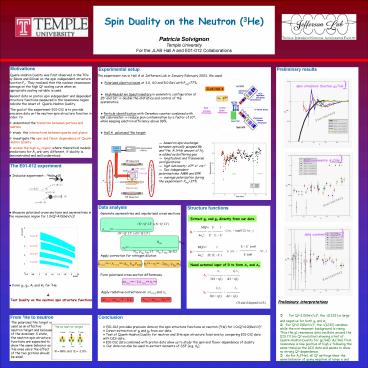Spin Duality on the Neutron 3He - PowerPoint PPT Presentation
1 / 1
Title:
Spin Duality on the Neutron 3He
Description:
Spin Duality on the Neutron (3He) Patricia Solvignon. Temple University. For the JLAB Hall A and E01-012 Collaborations. The E01-012 experiment ... – PowerPoint PPT presentation
Number of Views:37
Avg rating:3.0/5.0
Title: Spin Duality on the Neutron 3He
1
Spin Duality on the Neutron (3He) Patricia
Solvignon Temple University For the JLAB Hall A
and E01-012 Collaborations
Motivations Quark-Hadron Duality was first
observed in the 70s by Bloom and Gilman on the
spin independent structure function F2. They
realized that the nucleon resonances average on
the high Q2 scaling curve when an appropriate
scaling variable is used. Recent data on proton
spin independent and dependent structure
functions measured in the resonance region
indicate the onset of Quark-Hadron Duality. The
goal of the experiment E01-012 is to provide
precision data on the neutron spin structure
function in order to ? understand the
transition between partons and hadrons ? study
the interactions between quarks and gluons ?
investigate the spin and flavor dependence of
Quark-Hadron Duality ? access the high xbj
region, where theoretical models predictions for
A1 are very different, if duality is demonstrated
and well understood.
Experimental setup The experiment ran in Hall A
at Jefferson Lab in January-February 2003. We
used
Preliminary results
Spin structure function g1(3He)
- Polarized electron beam at 3.0, 4.0 and 5.0 GeV
with Pavg77. - High Resolution Spectrometers in symmetric
configuration at 25o and 32o ? double the
statistics and control of the systematics. - Particle identification with Cerenkov counter
combined with EM calorimeter ? reduce pion
contamination by a factor of 104, while keeping
electron efficiency above 99. - Hall A polarized 3He target
- based on spin exchange between optically pumped
Rb and 3He. A little amount of N2 is added as
buffering gas. - longitudinal and transverse configurations
- high luminosity 1036 s-1 cm-2
- Two independent polarimetries NMR and EPR
- average polarization during the experiment
Pavg37
Spin asymmetry A1(3He)
- The E01-012 experiment
- Inclusive experiment 3He(e,e)X
- Measure polarized cross sections and asymmetries
in the resonance region for 1.0ltQ2lt4.0(GeV/c)2
?
?
Data analysis
Structure functions
Generate asymmetries and unpolarized cross
sections
Extract g1 and g2 directly from our data
(N/ Q LT)-(N-/ Q- LT-) A/
/ (?) raw ??????????? (N/ Q
LT)(N-/ Q- LT-)
MQ2? E 1 g1 ??? ? ???
4?e2 E E E
Spin asymmetry A2(3He)
(??// tan(?/2) ??? )
Ncut
Ntrial ?oraw ??????? ???????
Ninc ?3He ?det LT Nacc Ltarg ?p ??
E E cos? ????? Esin?
MQ2?2 1 g2 ??? ?????
4?e2 2E(E E)
(- ??//
??? )
Apply correction for nitrogen dilution
A/ / (?) exp A/ / (?) raw /(fN2 Ptarg Pbeam)
?oexp ?oraw - 2(?N2/ ?3He)?N
Need external input of R to form A1 and A2
A// ? A? A1
???? - ???? D(1 ??) d(1 ??)
Form polarized cross section differences
??//(?) exp 2 A //(?)exp ?o exp
? A// A? A2
???? ???? D(1 ??) d(1 ??)
Apply radiative corrections on ??//(?) and ?o
A//(?) ??//(?) / 2?oborn
??//(?) ??//(?) exp R.C.
Preliminary interpretations
(D and d depend on R)
- For Q2lt2.0(GeV/c)2, the ?(1232) is large and
negative for both g1 and A1. - For Q2gt2.0(GeV/c)2, the ?(1232) vanishes while
the non-resonant background is rising. Thus the
g1 resonance data oscillate around the DIS fit
(no Q2-evolution) showing a hint of Quark-Hadron
Duality for g1(3He). A1(3He) from resonance is
now positive at high x following the same trend
as the DIS data and seems to show no strong
Q2-dependence. - As for A2(3He), all Q2 settings show the same
behavior of going negative at large x and agree
well with the DIS data
From 3He to neutron
Conclusion
The polarized 3He target is used as an effective
neutron target and because of the dominant S
state, the neutron spin structure functions are
expected to show the same behavior as 3He ones
since the effect of the two protons should be
small.
- E01-012 provides precision data on the spin
structure functions on neutron (3He) for
1.0ltQ2lt4.0(GeV/c)2. - Direct extraction of g1 and g2 from our data.
- Test of Quark-Hadron Duality for neutron and 3He
spin structure functions by comparing E01-012
data with DIS data. - E01-012 data combined with proton data allow us
to study the spin and flavor dependence of
duality. - Our data can also be used to extract moments of
SSF (e.g. d2).










![Top 5 Tennis Strings for Spin 2021 [Reviewed] PowerPoint PPT Presentation](https://s3.amazonaws.com/images.powershow.com/9683536.th0.jpg?_=202111150212)




















